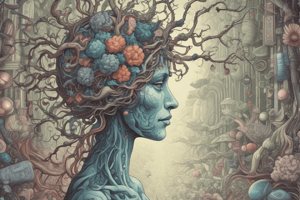Podcast
Questions and Answers
Which receptors do 1st generation (typical) antipsychotic drugs primarily act as antagonists for?
Which receptors do 1st generation (typical) antipsychotic drugs primarily act as antagonists for?
- D1 receptors
- Serotonin receptors
- D3 receptors
- D2 receptors (correct)
What is the mechanism of action for 2nd generation (atypical) antipsychotic drugs?
What is the mechanism of action for 2nd generation (atypical) antipsychotic drugs?
- D1 antagonists
- Serotonin-dopamine antagonists with more selectivity for D2 receptors (correct)
- D2 agonists
- Serotonin agonists
Which category of antipsychotic agents includes Phenothiazines and Thioxanthenes?
Which category of antipsychotic agents includes Phenothiazines and Thioxanthenes?
- Conventional Antipsychotic Agents (correct)
- Second-generation Antipsychotic Agents
- Atypical Antipsychotic Agents
- Major Tranquilizers
What are the typical antipsychotics used to treat specifically?
What are the typical antipsychotics used to treat specifically?
What is the main indication for Phenothiazines (major tranquilizers)?
What is the main indication for Phenothiazines (major tranquilizers)?
Flashcards
Target of 1st generation antipsychotics?
Target of 1st generation antipsychotics?
D2 receptors
Mechanism of 2nd gen antipsychotics?
Mechanism of 2nd gen antipsychotics?
Serotonin-dopamine antagonists with more selectivity for D2 receptors
Category of Phenothiazines and Thioxanthenes?
Category of Phenothiazines and Thioxanthenes?
Conventional Antipsychotic Agents
Typical antipsychotics treat?
Typical antipsychotics treat?
Signup and view all the flashcards
Main indication for Phenothiazines?
Main indication for Phenothiazines?
Signup and view all the flashcards
Study Notes
Antipsychotic Drugs
- 1st generation (typical) antipsychotic drugs primarily act as antagonists for dopamine (D2) receptors.
Mechanism of Action
- 2nd generation (atypical) antipsychotic drugs have a mechanism of action that involves blocking serotonin 5-HT2 receptors and dopamine D2 receptors, with a higher affinity for serotonin receptors.
Antipsychotic Agents
- Phenothiazines and Thioxanthenes are categorized as typical antipsychotic agents.
Typical Antipsychotics
- Typical antipsychotics are used to treat psychotic symptoms, including hallucinations, delusions, and disorganized thinking and behavior, in conditions such as schizophrenia, bipolar disorder, and psychotic depression.
Phenothiazines
- The main indication for Phenothiazines (major tranquilizers) is to treat psychosis, particularly in schizophrenia.
Studying That Suits You
Use AI to generate personalized quizzes and flashcards to suit your learning preferences.



